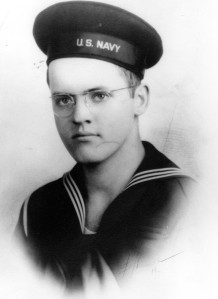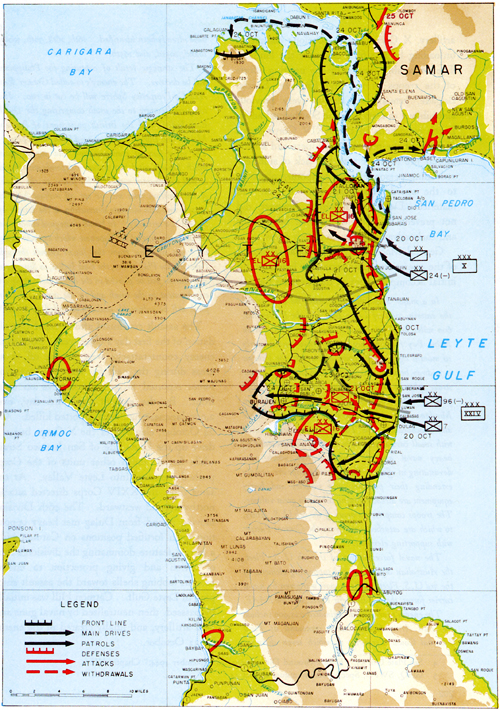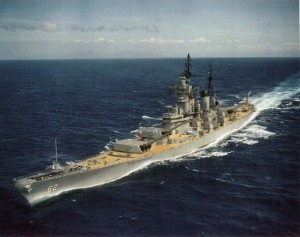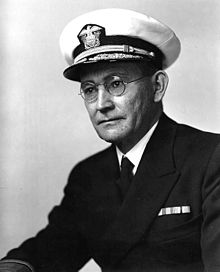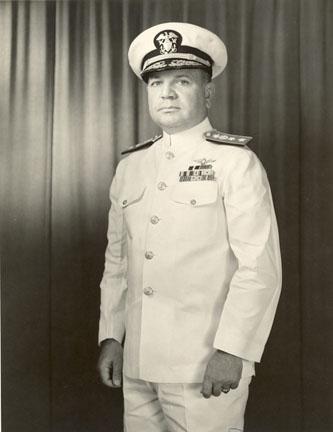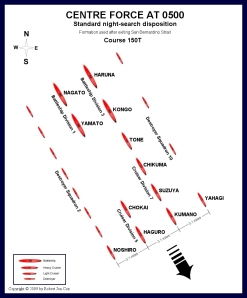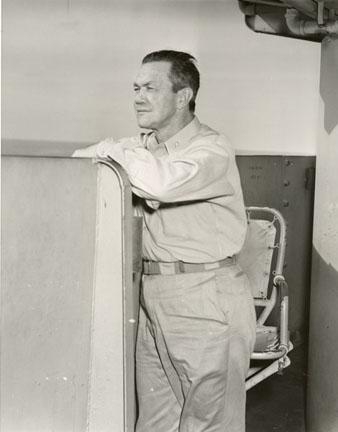October 1944 continues and my father, Seaman First Class, John Thomas Ryan is still serving on the USS Hornet (CV-12).
20-26 Oct 1944 – Strikes on Leyte supporting invasion of the Philippines as stated in the ships log for the USS Hornet (CV-12).
In my previous post I wrote about the Second Battle of the Philippine Sea (Leyte Gulf). The Battle of Leyte Gulf, also called the Battles for Leyte Gulf, and formerly known as the Second Battle of the Philippine Sea, is generally considered to be the largest naval battle of World War II and, by some criteria, possibly the largest naval battle in history. Since the Battle of Leyte Gulf consisted of four separate engagements between the opposing forces: the Battle of the Sibuyan Sea, the Battle of Surigao Strait, the Battle of Cape Engaño and the Battle off Samar, as well as other actions, I decided to break the story into multiple parts. In Part 1, I covered the background and the submarine action in Palawan passage on October 23, 1944. In Part 2, I wrote about the Battle of Sibuyan Sea. During my research for the previous post, I discovered a part of the separate story that needs a separate posting so for part 3, I write about Admiral Halsey’s decisions and the San Bernardino Strait. This post can be summed up in one phrase “Communication Breakdown.”
Task Force 34 / San Bernardino Strait
After the Japanese Southern and Center forces had been detected, but before Ozawa’s carriers had been located, Halsey and the staff of 3rd Fleet, aboard the battleship New Jersey, prepared a contingency plan to deal with the threat from Kurita’s Center Force.
Their intention was to cover the San Bernardino Strait with a powerful task force of fast battleships supported by two of the 3rd Fleet’s equally swift carrier groups. The battleship force was to be designated Task Force 34 (TF 34) and to consist of four battleships, five cruisers and 14 destroyers under the command of Vice Admiral Willis A. Lee.
Rear Admiral Ralph E. Davison of TG 38.4 was to be in overall command of the supporting carrier groups.
At 15:12 on 24 October, Halsey sent an ambiguously worded telegraphic radio message to his subordinate task group commanders, giving details of this contingency plan:
BATDIV 7 MIAMI, VINCENNES, BILOXI, DESRON 52 LESS STEVEN POTTER, FROM TG 38.2 AND WASHINGTON, ALABAMA, WICHITA, NEW ORLEANS, DESDIV 100, PATTERSON, BAGLEY FROM TG 38.4 WILL BE FORMED AS TASK FORCE 34 UNDER VICE ADMIRAL LEE, COMMANDER BATTLE LINE. TF 34 TO ENGAGE DECISIVELY AT LONG RANGES. CTG 38.4 CONDUCT CARRIERS OF TG 38.2 AND TG 38.4 CLEAR OF SURFACE FIGHTING. INSTRUCTIONS FOR TG 38.3 AND TG 38.1 LATER. HALSEY, OTC IN NEW JERSEY.
—Morison (1956)
Halsey sent information copies of this message to Admiral Nimitz at Pacific Fleet headquarters and Admiral King in Washington; however he did not include Admiral Kinkaid (7th Fleet) as information addressee. The message was picked up by 7th Fleet, anyway, as it was common for admirals to direct radiomen to copy all message traffic they detected, whether intended for them or not. As Halsey intended TF 34 as a contingency to be formed and detached when he ordered it, when he wrote “will be formed” he meant the future tense; but he neglected to say ‘when’ TF 34 would be formed, or under what circumstances. This omission led Admiral Kinkaid of 7th Fleet to believe Halsey was speaking in the imperative, not the future tense, so he concluded TF 34 had been formed and would take station off the San Bernardino Strait. Admiral Nimitz, in Pearl Harbor, reached exactly the same conclusion. Halsey did send out a second message at 17:10 clarifying his intentions in regard to TF 34:
IF THE ENEMY SORTIES (THROUGH SAN BERNADINO STRAIT) TF 34 WILL BE FORMED WHEN DIRECTED BY ME.
—T.J. Cutler (1994)
Unfortunately, Halsey sent this second message by voice radio, so 7th Fleet did not intercept it, and Halsey did not follow up with a telegraphic message to Nimitz or King. The serious misunderstanding caused by Halsey’s ambiguous wording of his first message and his failure to notify Nimitz, King, or Kinkaid of his second clarifying message was to have a profound influence on the subsequent course of the battle.
Halsey’s decision (24 October 1944)
The 3rd Fleet’s aircraft failed to locate Ozawa’s Northern (decoy) force until 16:40 on 24 October. This was largely because 3rd Fleet had been preoccupied with attacking Kurita’s Centre force and defending itself against the Japanese air strikes from Luzon. Thus, ironically, the one Japanese force that wanted to be discovered was the only force the Americans had not been able to find. On the evening of 24 October, Ozawa intercepted a (mistaken) American communication describing Kurita’s withdrawal; he therefore began to withdraw, too. However, at 20:00, Soemu Toyoda ordered all his forces to attack “counting on divine assistance.” Trying to draw 3rd Fleet’s attention to his decoy force, Ozawa reversed course again and headed southwards towards Leyte.
Halsey was convinced the Northern Force constituted the main Japanese threat, and he was determined to seize what he saw as a golden opportunity to destroy Japan’s last remaining carrier strength. Believing the Center Force had been neutralized by 3rd Fleet’s air strikes earlier in the day in the Sibuyan Sea, and its remnants were retiring, Halsey radioed (to Nimitz and Kinkaid):
CENTRAL FORCE HEAVILY DAMAGED ACCORDING TO STRIKE REPORTS.
AM PROCEEDING NORTH WITH THREE GROUPS TO ATTACK CARRIER FORCES AT DAWN—Morison (1956)
The words “with three groups” proved dangerously misleading. In the light of the intercepted 15:12 24 October “…will be formed as Task Force 34” message from Halsey, Admiral Kinkaid and his staff assumed, as did Admiral Nimitz at Pacific Fleet headquarters, that TF 34—commanded by Lee—had now been formed as a separate entity. They assumed that Halsey was leaving this powerful surface force guarding the San Bernardino Strait (and covering the Seventh Fleet’s northern flank), while he took his three available carrier groups northwards in pursuit of the Japanese carriers. But Task Force 34 had not been detached from his other forces, and Lee’s battleships were on their way northwards with the 3rd Fleet’s carriers. Halsey had consciously and deliberately left the San Bernardino Strait absolutely unguarded. As Woodward wrote: “Everything was pulled out from San Bernardino Strait. Not so much as a picket destroyer was left”.
Halsey and his staff officers ignored information from a night reconnaissance aircraft operating from the light carrier Independence that Kurita’s powerful surface force had turned back towards the San Bernardino Strait, and that after a long blackout, the navigation lights in the strait had been turned on.
When Rear Admiral Gerald F. Bogan—commanding TG 38.2—radioed this information to Halsey’s flagship, he was rebuffed by a staff officer, who tersely replied “Yes, yes, we have that information.
” Vice Admiral Lee, who had correctly deduced that Ozawa’s force was on a decoy mission and indicated this in a blinker message to Halsey’s flagship, was similarly rebuffed. Commodore Arleigh Burke and Commander James Flatley of Vice Admiral Marc Mitscher’s staff had come to the same conclusion. They were sufficiently worried about the situation to wake Mitscher, who asked, “Does Admiral Halsey have that report?” On being told that Halsey did, Mitscher—knowing Halsey’s temperament—commented, “If he wants my advice he’ll ask for it” and went back to sleep.
The entire available strength of 3rd Fleet continued to steam northwards, leaving the San Bernardino Strait completely unguarded.
As in most endeavors today, communication is an important aspect of carrying out an operation. As I continue my research, I will see if this serious breakdown in communication will have a major effect on the war. In my next post, part 4 of the Battle of Leyte Gulf, I will write about the Battle of Surigao Strait on 25 October 1944.
